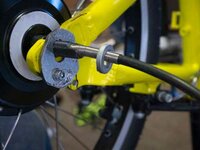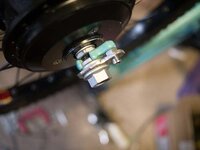Take a magnet to the front fork. If it sticks, it should be fine. Lots of material there. If it is steel should not be a problem. I think I see a little rust, but pictures can fool one. I made my torque arms out of bed frame rails, but amazon ones might work, although a little shorter than the 3 1/2" ones I made. Don't rely on worm hose clamps for torque resistance, use solid steel. Made my clamps out of box fan shell. that extended washer to the fender screw hole in the lower picture looks way too short to me.
Edit, that is comfort fork. Suspensions and front hub motors don't mix.
I've put a 1300 W & a 500 W front geared hub motors on the bike shown left. $221 1300 watt one wore out at 4500 miles, replaced in 2 afternoons with a $720 Mac12 that I hope lasts longer. I carry groceries or ag supplies on the back, so having the motor & battery on the front balances the bike better. I had a rear 1000 W dd hub motor on it, didn't like it. Mainly because the rear motor required a 7 speed freewheel, and the unpowered bike came with an 8 speed sprocket cluster that was much nicer. 11-32 ratios, which I could never find available in 7 speed freewheels (they exist in the catalog).
Only downfall to front hub motor, IMHO, is possible loss of traction on wet rocks, slick steel plates, wet or muddy wood bridge planks. Don't use the motor in those situations. I don't, & I haven't fallen off this bike in ~6000 miles so far. Upside to front hub motor, easy to change tube if you get a flat. I turn the bike over, don't even unplug the motor cables. When I had a display I mounted it on standoffs closer to me that would rotate when loosened if I wanted to turn the bike upside down. But the display leaked in the rain & fogged, so I just deleted it. No downside now to flipping the bike over on handgrips & seat.
Biggest downfall to that bike is rim brakes, IMHO. Rim brakes don't work in the rain. Coaster brakes & disk brakes do. Might be worth a new bike to get disk brakes, if you ever ride in the rain. I do, it rains 200+ days a year here. These days people say you don't save a lot on a stripper bike versus a conversion. I saved about $1500, but stretch frame cargo bikes are a category where electrified models have a high markup. Only 1 brand of 26" wheel bike fit 28" leg me in 2017, yubabike drop frame bodaboda, but now there is blix packa with 24" wheels. Not many other bikes have bosses in the frame to mount the battery to the front without swinging it around with the handlebars.




